Weekly Writ 8/14: Byelection benchmarks for Pierre Poilievre
How to judge the scores the Conservatives and Liberals will put up on Monday. Plus, byelection results in Quebec and Prince Edward Island.
Welcome to the Weekly Writ, a round-up of the latest federal and provincial polls, election news and political history that lands in your inbox every Thursday morning.
Going into Monday’s federal byelection in the Alberta riding of Battle River–Crowfoot, the only real question is what number Pierre Poilievre will put up. It’s one of the safest Conservative ridings in the country, so it is nearly impossible to imagine that Poilievre will fail to secure the seat that Damien Kurek won with 82.8% of the vote less than four months ago.
That doesn’t mean there won’t be some surprises or that some of the candidates — including Poilievre himself — could outperform or underperform expectations.
But how should we judge the results when they finally come in?
We can look at the history of the riding, as well as current polling trends, to set some benchmarks to aid us in assessing how well the Conservatives (and the Liberals, hey why not?) do.
The charts below show the results for both the Conservatives and Liberals in Battle River–Crowfoot (and, prior to 2015, the Crowfoot riding) since the 2004 election. Party leaders at the time are shown as well as the election year.
This gives us a very clear indication of just how consistent Conservative support has been in Battle River–Crowfoot over the last two decades. Results have always clustered between 80% and 86%, with one exception. The Conservatives got just over 71% of the vote in the 2021 election, when the People’s Party (and, to a lesser extent, the Maverick Party) ate into the Conservative vote.
Because the Conservatives have so regularly received at least 80% of the vote, it would be a knock against Poilievre if he fails to clear that bar. It’s worth noting that the three lowest results the Conservatives have gotten in this riding (in 2004, 2015 and 2021) were all elections in which the Conservatives did not form government. They also didn’t form government in 2019 or 2025, two of the top three elections for the Conservatives in this riding, but that just emphasises the point that the Conservatives are able to do very well in this part of Alberta even when the party isn’t winning nationally.
Two recent polls (discussed below) that reported results for Alberta suggest the Conservatives haven’t lost much support in the province. Abacus Data puts the party at 62%, while Pallas Data has them at 64%. The average of 63% is just below the 63.6% the Conservatives managed in Alberta in April’s election. That small drop means the polling benchmark for Poilievre is 82% — down less than a point from Kurek’s result.
What this means is that if Poilievre does worse than 82% we can say that he has underperformed what the polls say his result should be in Battle River–Crowfoot. If he beats 82%, then he is beating the Conservatives’ polls in Alberta. His result relative to this benchmark will give us one clue as to how voters have reacted to his candidacy.
As for the Liberals, they have never done well in this riding. In fact, their result this year of 11.7% was their best in at least the last two decades. Their next-best result was just over 9%, when Justin Trudeau first swept to power in 2015.
Generally, though, the Liberals have received between 4% and 8% of the vote in this riding. And the polls suggest that the Liberals have taken a small step back in Alberta. Abacus has them at 27% and Pallas puts them at 21%. The average of 24% is about four points below their performance in April, which drops the polling benchmark for the Liberals down to 8%. Above that, and Darcy Spady is beating the Liberals’ current polls in the province. Below that and he is underperforming.
In addition to the actual number that Poilievre puts up, I’m interested to see which candidate is able to garner the most anti-Poilievre votes. Normally, that would be the Liberals. But there’s been a fair bit of attention paid to Independent candidate Bonnie Critchley, and I wouldn’t be surprised if some Liberal-leaning voters lend their ballots to her as a way to try to block Poilievre. It seems unlikely that any other candidate will crack the Top 3, but we’ll see how it plays out on Monday night (and into the wee hours of Tuesday morning).
I’ll delve into the results next week. Until then, here is what’s in this instalment of the Weekly Writ:
News on some surprising byelection results in Quebec and Prince Edward Island that do not bode well for the governing parties in both provinces.
Polls show stable summer trends, plus we have some new numbers on Quebec sovereignty and views on Israel and Gaza.
#EveryElectionProject: Saskatchewan’s second election (ever).
The first Weekly Writ of every month is free to all subscribers. If you haven’t already upgraded your subscription and would like to receive it every Thursday — as well as support the work I’m doing — upgrade today!
NEWS AND ANALYSIS
Parti Québécois wins third consecutive byelection
The much-anticipated Arthabaska byelection delivered a comfortable victory to the Parti Québécois, marking the party’s third consecutive byelection gain since the 2022 provincial election in Quebec, all at the expense of the CAQ.
Alex Boissonneault, a former journalist and radio host, took 46.4% of the vote in this riding, located in the Centre-du-Québec region and centred on the small city of Victoriaville. This represented a remarkable gain of 36 points for the PQ, even beating the PQ’s stellar 34-point rise in the Terrebonne byelection in March.
Much of that newfound support came from the governing Coalition Avenir Québec, which fell from 51.8% in 2022 to just 7.2% on Monday night. That net 81-point swing, were it replicated across the province, would cost the CAQ every seat that it won in the last election.
Éric Duhaime, the seatless leader of the Quebec Conservatives, tried his luck in this riding. He successfully increased the party’s vote share by 10 points, but he nevertheless finished well back of Boissonneault with 35%. While it was a risk for Duhaime to run in this riding, it will undoubtedly be a disappointment that the party’s significant efforts to get him elected here (and deliver the PCQ its first seat in the National Assembly) came to naught.
The Liberals managed a modest 5.5-point increase to 9.3%, but it appears that Chantale Marchand, their candidate, was squeezed out in the polarized Boissonneault vs. Duhaime contest. The Liberals had no hope to win this riding, but this result is still well below what one might expect from a party that is running second in the polls since the arrival of Pablo Rodriguez as leader.
Turnout was an astonishing 60% in this byelection, all the more impressive considering it was held in the middle of the summer. The high turnout and the low result for the CAQ is a rebuke to François Legault’s government. The premier said in a concession speech Monday night (it’s unusual to have a party leader present on a byelection night when the result is expected to be so poor) that voters in Arthabaska were speaking for all Quebecers in expressing their disappointment in the government. At some point, however, Legault might have to consider stepping aside for the good of the party he founded — though there is no sign of that happening just yet.
But it’s important to remember that this byelection had a specific dynamic that will not be very present in the next general election. It was very much a PQ vs. Conservative contest, something we won’t see much outside of the Quebec City region. It polarized the electorate between the two parties, especially considering the unpopularity of Duhaime. In June, Léger found that 50% of Quebecers held a bad opinion of Duhaime, twice the number who held a good opinion. That bad-opinion score was the highest of any politician tested, with the sole exceptions of François Legault and Pierre Poilievre. While many voters in Arthabaska might have enthusiastically voted for the Parti Québécois (the party is leading in the polls, after all), there was undoubtedly also a motivated anti-Duhaime vote that went Boissonneault’s way. The PQ won’t be able to replicate this climate throughout the province in 2026.
But the results here do suggest that the PQ is on track for a victory and that the CAQ is on track for catastrophe in 2026, if these trends hold. The PQ hasn’t won in Arthabaska since 1998, the last election in which the Parti Québécois formed a majority government. And the CAQ, once dominant, is now facing a wipeout.
Liberals score upset in PEI byelection
Prince Edward Island has been a polling desert for nearly a year, so the massive shifts that occurred in the two provincial byelections held on Tuesday came as a bit of a surprise. The governing Progressive Conservatives, who won both Charlottetown-Hillsborough Park and Brackley-Hunter River handily in 2023, managed to hold on to only one of their two seats as the Liberals scored an upset win.
Carolyn Simpson took 47.7% of the vote in Charlottetown-Hillsborough Park, a massive gain of nearly 35 points for the Liberals since the last election. That nearly all came at the expense of the PCs, who were down 24 points to just 38.2%. The replacement of Natalie Jameson, who resigned her seat to run (unsuccessfully) for the federal Conservatives, with her husband Dennis does not appear to have been well-received. Simpson, a public servant and educator, benefited from the discontent with that swap as well as concerns over healthcare in PEI.
The Greens also lost ground to the Liberals, dropping eight points to 11.3%. The Liberal victory in Charlottetown-Hillsborough Park solidifies the party’s hold on the official opposition, as the Liberals and Greens had been tied at three seats apiece before this Liberal gain.
The PCs held on in Brackley-Hunter River, the district of former premier and PC leader Dennis King. The PCs’ Kent Dollar held on easily enough with 50.1% of the vote, though that still represented a drop of 18 points for the party.
Dollar didn’t face much of a challenge because the fight for second was close, with both the Greens and Liberals making gains and divvying up the non-PC vote between them. The Greens were up six points to 23.7%, enough to edge out the Liberals, who were up 12 points to 23.2%.
The results in these two districts suggest that there has been a significant swing from the PCs to the Liberals. On average, the Liberals were up 23 points in these two districts and the PCs were down 21 points. The Greens and NDP hardly budged.
If we apply those swings to the 2023 results, we’d end up with the Liberals beating the PCs by about five percentage points across PEI. A uniform swing of this magnitude would deliver 13 seats to the Liberals, with 10 going to the PCs and four to the Greens (or nine PC and five Green if we assume the Greens hold their Borden-Kinkora gain from last year’s byelection).
While local dynamics are undoubtedly the primary factor moving the numbers in Prince Edward Island, it is hard not to also see in these results that the post-Trudeau renewal of the Liberal brand has helped boost the PEI Liberals, too. The party doesn’t even have a permanent leader in place (the Greens recently named their new leader) but nevertheless made these significant gains.
Notably, they appear to have come from the PCs, rather than from the Greens. This isn’t the Liberals getting the anti-PC to coalesce around them, as the Greens were able to hold most of their support. This is the Liberals getting back some of the PC vote they’ve lost over the last decade. That’s a big problem for the PEI PCs.
POLLING HIGHLIGHTS
Liberals holding their polling advantage
The mid-summer polling remains good for the Liberals, who led in four recent polls all conducted (at least partially) in August by Abacus Data, Pallas Data, Nanos Research and Liaison Strategies.
The polls award the Liberals between 43% and 45% support, suggesting the party is holding the vote they received in the April election. The Conservatives, however, managed between 32% and 40% in these polls, indicating some slippage.
The New Democrats scored between 7% and 12% in these four surveys. Interestingly, the two polls that have the NDP in double-digits are also the polls where the Conservatives have their lowest support. The Bloc Québécois is holding the vote it got in the last election but has made no further progress, which means the Liberals would still be favoured to win a majority of Quebec’s seats if an election were held today. And, with their wider advantage over the Conservatives nationally, they’d also be very likely to find the three seats they needed to form a majority government in April.
But, there’s nothing much new in that. The Liberals have been holding and the Conservatives have been knocked down a peg ever since the last election. The trend lines are not showing that much has changed, and that goes beyond just the ballot question. Here are a few other tidbits from these polls, which broadly show stability as we roll through what has been an otherwise tumultuous summer:
Abacus finds that Mark Carney’s positive impressions are holding steady at 48%. He’s scored either 48% or 49% since mid-June. His negatives stand at 29%. By contrast, Pierre Poilievre registers a 42% positive and 41% negative rating. While drawing even nationally, he’s underwater primarily in Quebec and among older voters.
The choice between Carney and Poilievre still strongly favours the incumbent prime minister. Nanos Research continues to give Carney a significant lead on who Canadians prefer to be prime minister at 52% to just 24% for Poilievre. Carney is polling well above support for the Liberal Party, while Poilievre is polling well below that of the Conservatives.
Liaison Strategies has even better numbers for Carney. His approval rating is a glittering 64%, twice as high as his disapproval score. Though this is the first numbers we’ve seen published by Liaison since the campaign, the polling firm reported its previous soundings in their new report and they show that Carney’s approval has been holding at between 61% and 68% post-election. However, Liaison finds that Carney’s numbers are less impressive on specific issues, with just half or a little more than half of respondents approving of his performance on the economy, immigration, the environment, Canada/US relations and foreign affairs. His disapproval is higher than his approval ratings on cost of living and crime.
The rising cost of living (62%) and Donald Trump (44%) are the top two issues selected by Canadians, according to Abacus. Among those who rank these issues in their top three, the Conservatives enjoy a 10-point edge on the cost of living while the Liberals have a 37-point edge on Trump. Nanos, on the other hand, finds Trump to be the top (unprompted) issue at 23%, followed by jobs and the economy (17%).
POLLING NEWS BRIEFS
QUEBEC SOVEREIGNTY - New polling from CROP finds that 41% of Quebecers would vote for sovereignty, while 44% say they are “favourable” to the notion of Quebec independence. Support was highest among younger Quebecers and lowest among older Quebecers, which is a reversal of traditional patterns. There is some discrepancy in recent polls as to whether younger Quebecers are indeed more pro-independence then the older generations who voted in the 1980 and 1995 referendums.
ISRAEL AND GAZA - As the conflict in Gaza drags on, the Angus Reid Institute finds that more Canadians are sympathizing with the Palestinians than with the Israelis. Shortly after the October 7 attacks, 28% of Canadians polled said their sympathies lay with Israel and 18% the Palestinians, with 31% saying “both”. In its latest poll, ARI finds sympathy with the Israelis has dropped to 19% and sympathy for the Palestinians has increased to 37%. By a two-to-one margin, Canadians polled also believe that Israel is committing a genocide against the Palestinians.
12-MONTH ELECTORAL CALENDAR
August 18: Federal byelection in Battle River–Crowfoot
August 26: Manitoba provincial byelection in Spruce Woods
September 24: B.C. Green leadership
Candidates: Adam Bremner-Akins, Jonathan Kerr, Emily Lowan
October 2: Municipal elections in Newfoundland and Labrador
October 4: P.E.I. Liberal leadership
Candidates: Robert Mitchell
October 14: Newfoundland and Labrador provincial election
October 20: Municipal elections in Alberta
October 27: Nunavut territorial election
November 2: Municipal elections in Quebec
November 3: Yukon territorial election
November 9: Québec Solidaire co-leadership
Candidates: Yv Bonnier-Viger, Étienne Grandmont, Geru Schneider, Sol Zanetti
March 29: Federal NDP leadership
May 11: Municipal elections in New Brunswick
Byelections yet to be scheduled
NB - Miramichi West (to call by September)
Party leadership dates yet to be set
Manitoba Liberals (Dougald Lamont resigned on Oct. 3, 2023)
P.E.I. PCs (Dennis King resigned on February 20, 2025)
Future party leadership dates
October 17, 2026: New Brunswick Progressive Conservatives
November 21, 2026: Nova Scotia Liberals
ON THIS DAY in the #EveryElectionProject
Walter Scott goes 2-0
August 14, 1908
This was originally published on August 14, 2024.
Early elections in Saskatchewan and Alberta were relatively easy ones for the Liberals to win. Voters in those new provinces had never had a government of any other hue. Being an incumbent with no predecessor had its perks.
Walter Scott was one of those Liberals in Saskatchewan. Appointed the first premier while Wilfrid Laurier’s Liberals ruled in Ottawa, Scott won the first election in 1905 with ease. As the province continued to develop and grow, things were going well enough that Scott called his second election ahead of schedule, dissolving the legislature on July 20, 1908.
The province had grown so much that the legislature had increased in size from 25 to 41 seats. It was one of the reasons used to justify the early election call. Another reason, which Scott denied, was that Laurier was planning an election for later in 1908, and wanted to gauge public opinion in Western Canada.
One of those making that charge was Frederick Haultain, still leader of the Provincial Rights Party. Leading what was the Conservative Party in all but name, Haultain had run the territorial administration before the creation of the province. In 1905, he was a man with a governing record. By 1908, he was just an opposition leader.
But “his work during a period in Opposition had retained the respect of the public,” according to the Canadian Annual Review of Public Affairs, “his reputation for honesty and high character was general, his faculty of speech excellent, with just that touch of humour which goes far in a politician.”
On the other hand, “Scott was a shrewd and aggressive politician, thoroughly versed in Western ways and political conditions, a man of the people, personally popular, and in close touch with the powers at Ottawa.”
Scott went to the people with a program for more support for the agricultural sector, free textbooks for students and the continued extension of railway lines and the province’s telephone network. He was pitched as “the man who does things”, a Liberal who could work closely with Laurier’s government in Ottawa to deliver for Saskatchewan.
The premier also wasn’t afraid to throw a little mud.
In Regina, he attacked the Provincial Rights candidate H.W. Laird. “I make the absolute charge the Mr. Laird was a grafter when he was in the [municipal] Council;” he said, “and let him take me to Court, I will prove the charge.”
Laird did, taking Scott to court over charges of libel. He staked his local campaign on winning the case, saying he would resign if Scott’s charges were later proven to be true. The trial was held only after the election. It was all moot, anyway — Laird lost his bid for a seat, as well as the libel suit.
Both Scott and Haultain mounted extensive speaking tours across the province. The Provincial Rights leader admitted he couldn’t get the same deal out of Laurier as Scott could, but suggested that Saskatchewan voters would be smart to put his party in power in case Robert Borden’s Conservatives formed government after the next federal election.
Haultain was also big on railway development, wanting to build a government-owned railway to Hudson’s Bay with the help of Alberta and Manitoba. He also promised “no direct Provincial taxation except on corporations and railway earnings and on speculators’ lands in unorganized districts”, and was far more supportive of government ownership of things like telephones and grain elevators than Scott’s Liberals.
The message to voters from the Provincial Rights Party was a simple one, as laid out by the Regina Standard: “Vote for Haultain and the Hudson’s Bay Railway—to be built as a Western enterprise and paid out of our natural wealth. A vote for Scott means that a private company will own the road, but the people will pay for it.”
It was a message that was having some resonance amongst voters, and the Liberals were nervous they might lose a few seats.
The expanded legislature masked what were some Liberal losses. Though the party won 27 seats, an increase of 11 over the last election, they dropped 1.5 points in popular support and saw two key cabinet ministers, William Motherwell and James Calder, go down to defeat in their own ridings.
(They’d find their way back to the legislature when two successful Saskatchewan Liberals resigned their seats to run for Laurier’s Liberals later that year.)
The Provincial Rights Party saw a small increase in its vote to 48% and won five more seats, finishing with 14. Three of their gains came at the expense of Liberals in the northeast, along with rural ridings north and south of Regina.
But another majority government for Scott and the Liberals meant the end for Haultain and the so-called Provincial Rights Party. It adopted the Conservative name after Haultain stepped down as leader, though it didn’t improve its electoral record. The Liberals would keep winning in Saskatchewan for another 20 years.
That’s it for the Weekly Writ this week. The next episode of The Numbers will be dropping on Tuesday. The episode will land in your inbox but you can also find it on Apple Podcasts and other podcasting apps. If you want to get access to bonus and ad-free episodes, become a Patron here!



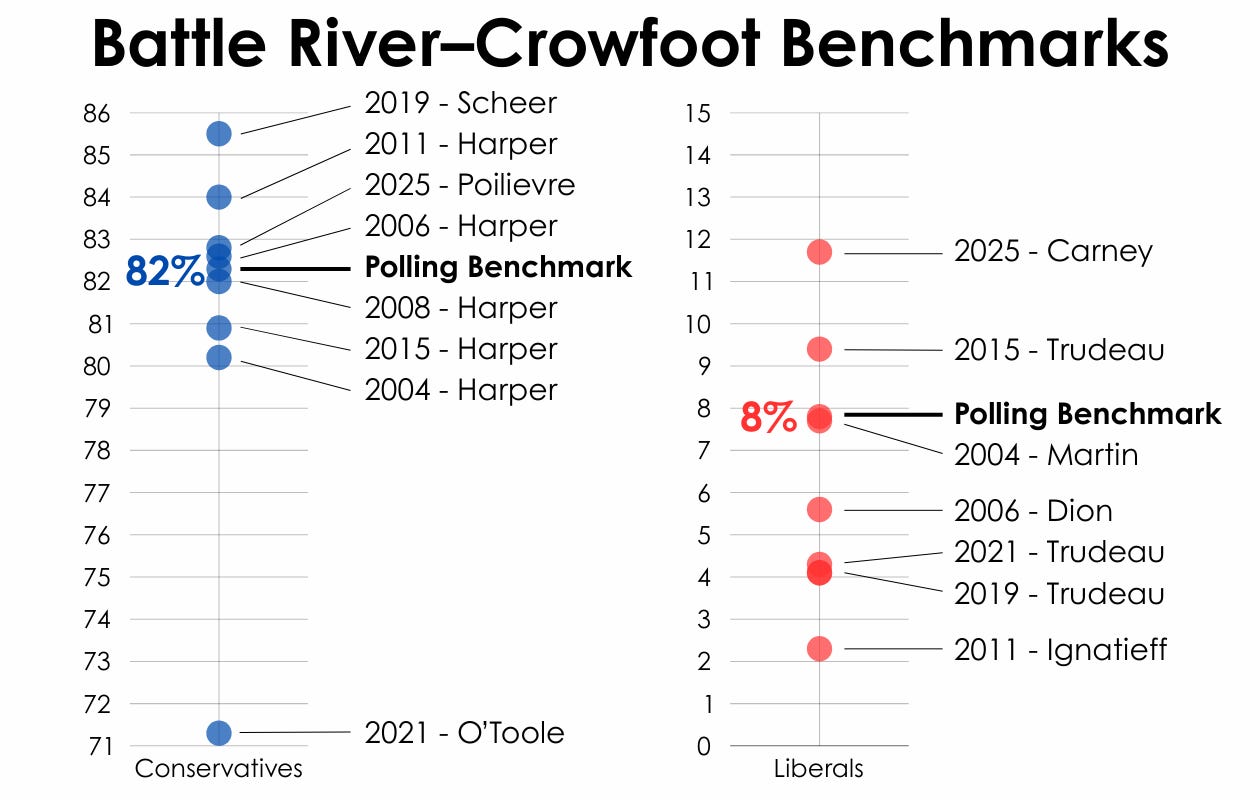
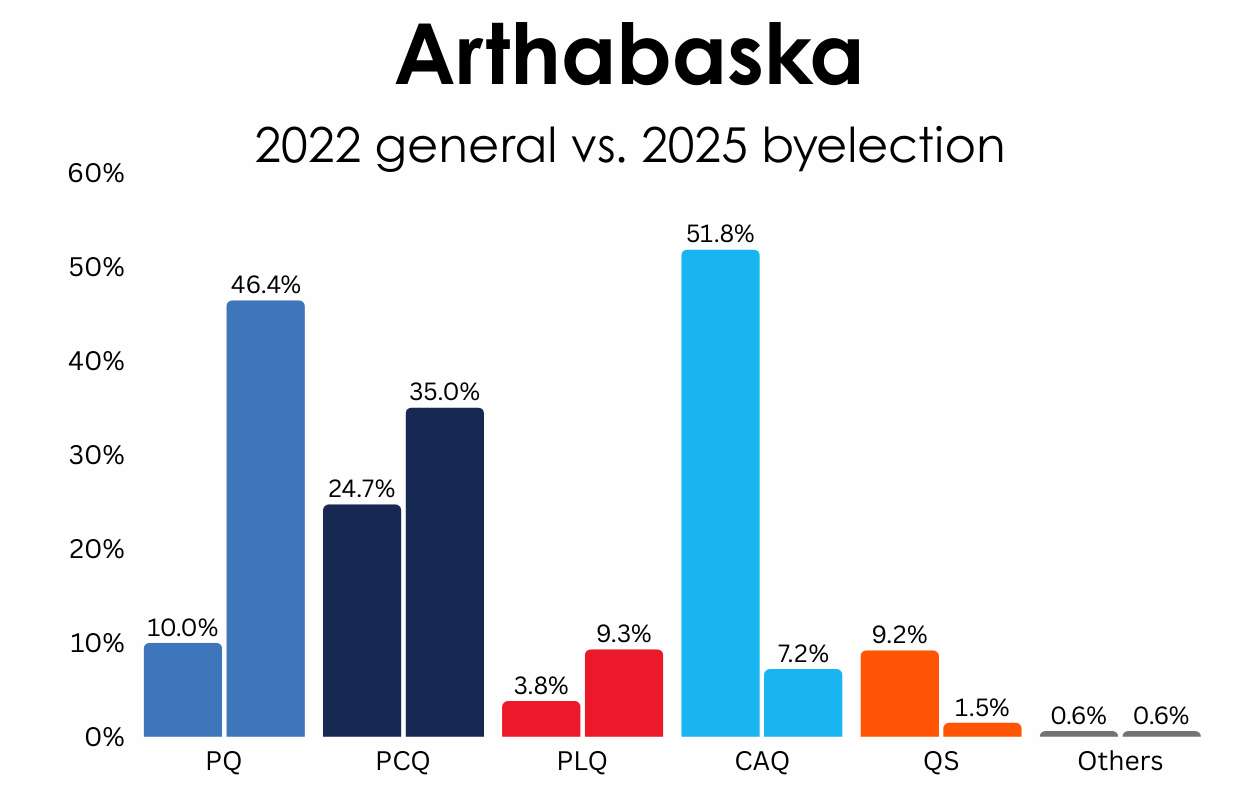
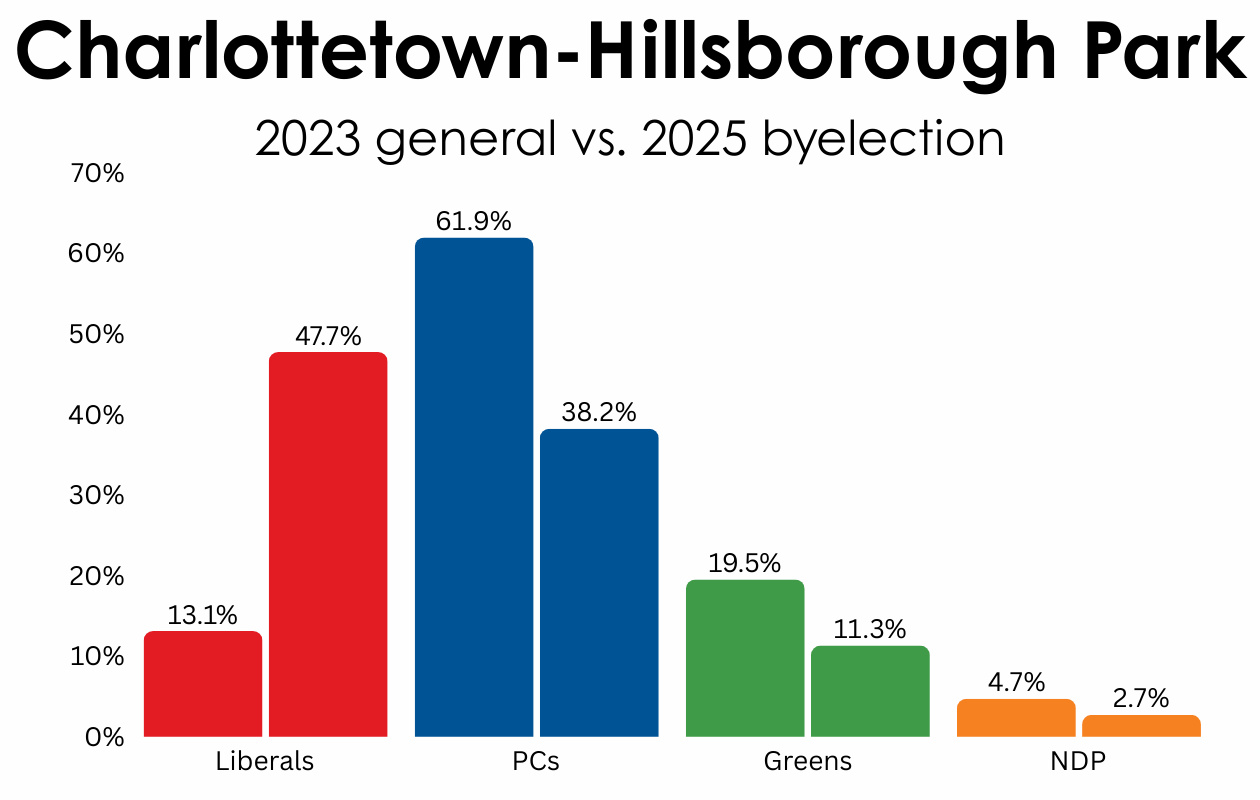
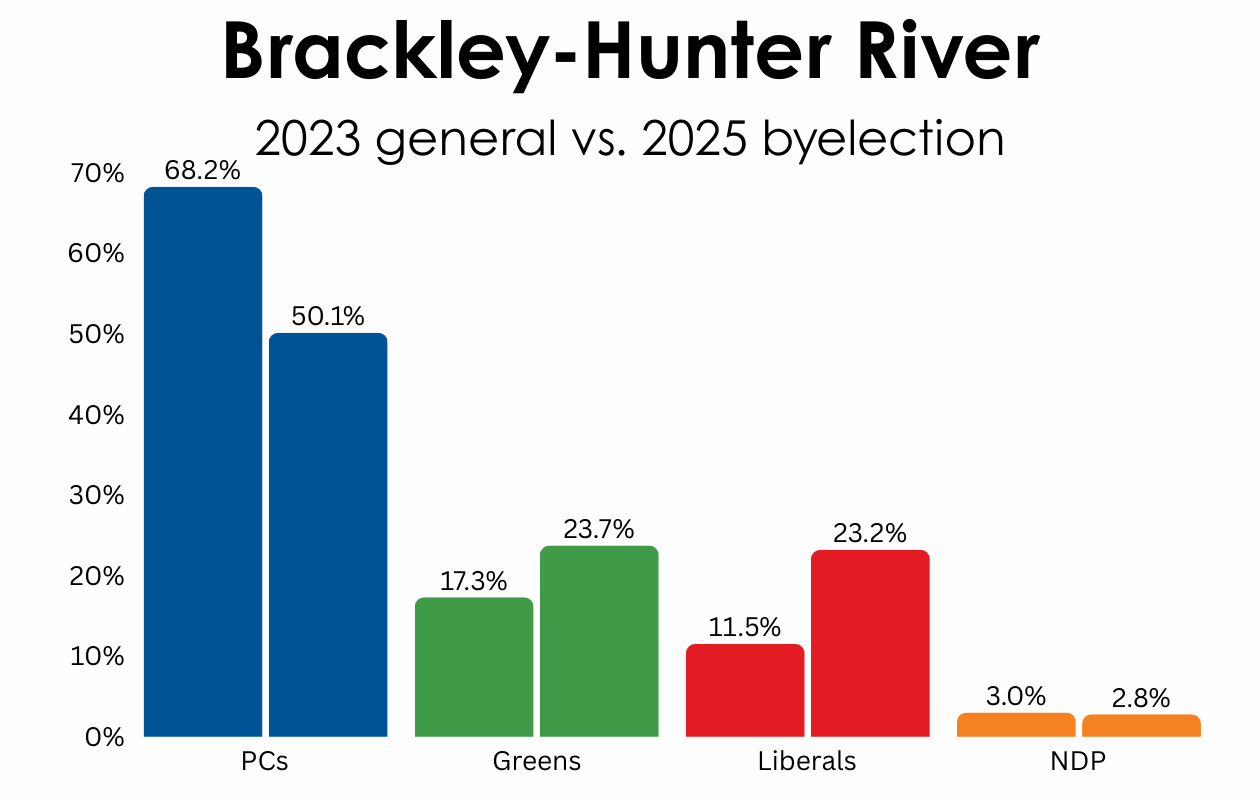
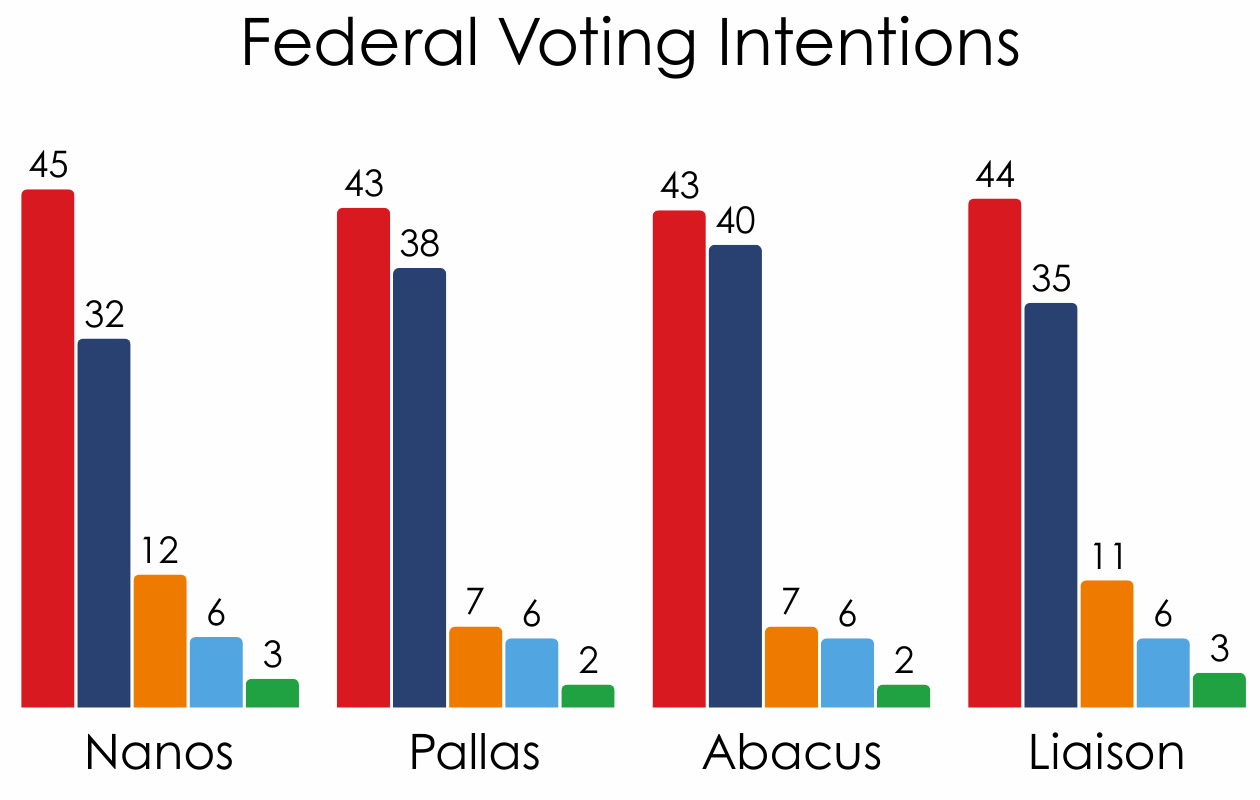
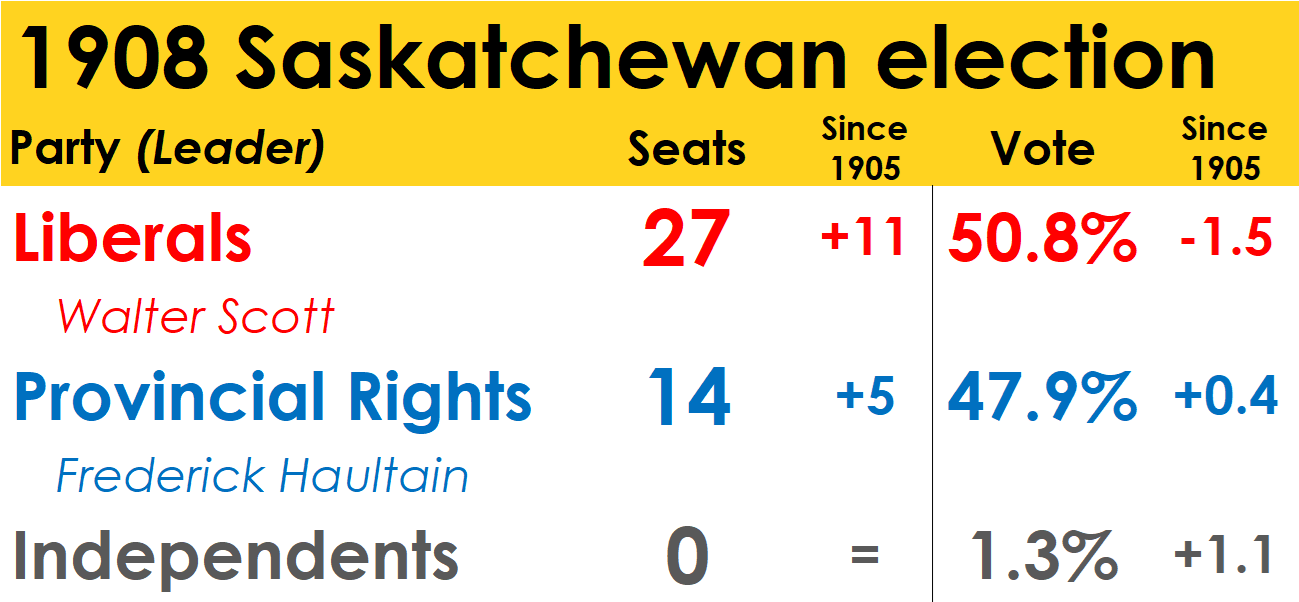
Is the People’s Party running a candidate again?